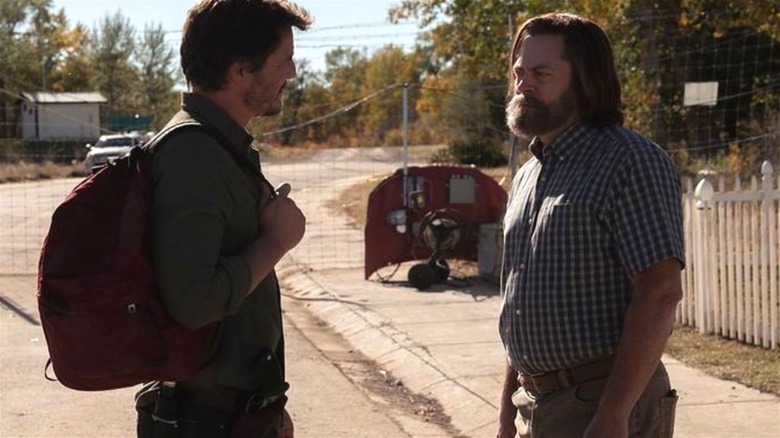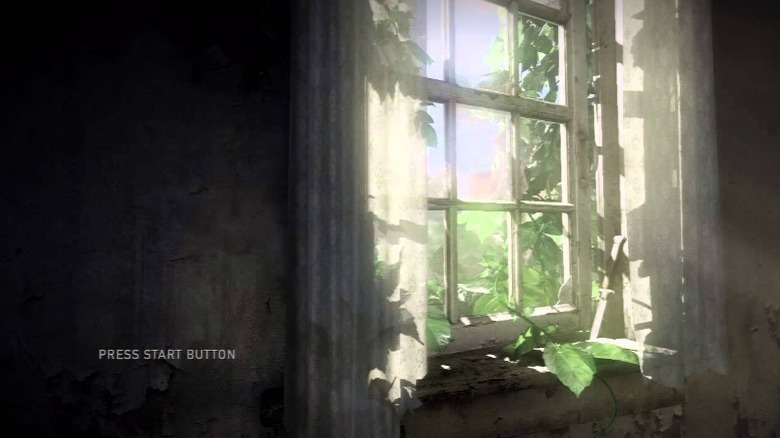The Final Shot Of This Week's The Last Of Us Was Designed To 'Honor' The Video Game [Exclusive]
This post contains spoilers for HBO's "The Last of Us" and the video game series of the same name.
Craig Mazin and Neil Druckmann's "The Last of Us" has managed to convey the essence of the video game series of the same name, while delivering three gut-wrenching episodes of television. Tragedy is an integral part of the show's worldbuilding, as survival is a luxury in a post-apocalyptic wasteland swarming with the infected, who harbor the singular goal of infecting every last human. Episode 3 somehow manages to heighten the pathos, focusing almost exclusively on Bill (Nick Offerman) and Frank (Murray Bartlett), who go from being guarded survivors who cross paths to lovers till they breathe their last. One of the most beautifully poignant episodes about two people in love ever made, episode 3 encapsulates the isolation, yearning, vulnerability, and pathos of loving someone as the world ends.
The handling of Bill and Frank's arc is markedly different from the video game — although the episode is utterly tragic, the duo's fate in the games is far more heartbreaking (to the point of being cruel). Here, the two stick together till the end, vowing to share their last moments together by recreating the circumstances of their first meeting. Bill chooses to die with Frank, warm in their bed, while leaving a window half-open and keeping the bedroom door locked. As if this wasn't devastating enough, the episode ends with a shot of the half-open window that overlooks the driveway, where Joel (Pedro Pascal) and Ellie (Bella Ramsey) can be seen driving away in Bill's Chevy S-10.
Apart from being a bittersweet full-circle moment that allows for Bill and Frank's deaths to skin in, this final window shot was exclusively designed to honor the game, according to series cinematographer Eben Bolter.
Honoring the roots
/Film's Valerie Ettenhofer recently interviewed Bolter about the making of "The Last of Us," and the series cinematographer revealed intriguing insights about bringing the unique world of the games to life. When asked about the haunting window shot at the end of episode 3, Bolter explained that it was a deliberate callback to the title screen of the original "Last of Us" video game, which featured a window shot players know and love. Apart from being a homage to the show's roots, the shot also ties in neatly with Bill and Frank's story, adding emotional closure to the especially heart-rending episode. Bolter remarked:
"...I wanted to somehow honor the famous shot of the window from 'The Last of Us' title screen. And I saw an opportunity to do an interesting crane shot that was about Joel and Ellie driving off into the next episode. And then a little reminder of where we had come from. We just wanted the echo of Bill and Frank to sort of linger when it cuts to black. And I think that was a nice way to do it."
Indeed, Bolter's decision to present this seemingly-simple crane shot adds significant weight to Bill and Frank's deaths by the time the episode ends, leaving viewers even more devastated. Moreover, the show has been sincere in terms of its deep respect for the games, reflected in the painstaking recreation of the fungi-engulfed world and the attention to detail directed toward mirrored in-game moments. This final shot maintains this sentiment and slowly shifts our attention back to the two souls who loved and lived intensely after finding each other, creating their own safe space in the heart of hell. If that's not heartbreakingly beautiful, I don't know what is.
How the final shot was pulled off
While explaining the mechanics of this final shot, Bolter explained how he first pitched the idea to Mazin, which led to the team figuring out a practical way to pull off the crane shot. What appears effortlessly seamless in the final product was actually "an expensive shot to do" and required "an awful lot of commitment" to execute. Bolter explained:
"The interior of the house [was] a soundstage, and the exterior of the house [was] all on location. So for that one shot, we actually had to build that corner of a room up on a rostrum, so that the camera could poke through the window and look out at the truck driving off, and the dolly back to reveal the room."
Bolter and his team absolutely deserve appreciation for doing spectacular work on the series, as the success of the show hinges on whether it can successfully evoke the kind of eerily-desolate world it is set in. Every location, whether internal or external, looks appropriately real and lived in, and the horror is heightened with the use of unsettling lighting, scale, and props that seem organic to the setting. For instance, the flooded hotel that Ellie, Joel, and Tess (Anna Torv) walk into in episode 2 expertly mirrors the corresponding location in the game, while fresh elements (like the frog sitting on a piano) add to the authenticity of it all.
The final shot in the latest episode is no different. It honors the source material, lingers on the essential heart of the episode, and acts as a window into the unforeseen future.


